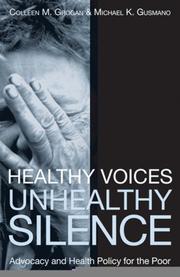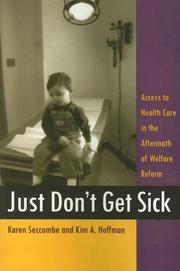| Listing 1 - 5 of 5 |
Sort by
|

ISBN: 1317121147 1281104310 9786611104313 0754684342 9780754684343 0754657620 9780754657620 9781315587066 9781317121138 9781317121145 9781138276000 1315587068 Year: 2007 Publisher: Aldershot, England Burlington, VT Ashgate Pub.
Abstract | Keywords | Export | Availability | Bookmark
 Loading...
Loading...Choose an application
- Reference Manager
- EndNote
- RefWorks (Direct export to RefWorks)
This book explores poor relief and charitable health care in French cities during the seventeenth century, a period that witnessed much reform and change in the way these services were administered. By reintegrating the social aspirations of urban elites into the history of French poor relief, it shows how they initiated reform in towns and cities when it suited them, but where such reforms were not perceived as needed, or not affordable, they ignored central government edicts to build new institutions. In other words, reforms of poor relief and health welfare were local and shaped by local ex
Social medicine --- Medical care --- Health care reform --- Health reform --- Health system reform --- Healthcare reform --- Medical care reform --- Reform of health care delivery --- Reform of medical care delivery --- Medical policy --- Health insurance --- Delivery of health care --- Delivery of medical care --- Health care --- Health care delivery --- Health services --- Healthcare --- Medical and health care industry --- Medical services --- Personal health services --- Public health --- Medical sociology --- Medicine --- Medicine, Social --- Public welfare --- Sociology --- Medical ethics --- Medical sociologists --- History --- Political aspects --- Social aspects --- Hospitals --- Hôpitaux --- Médecine sociale --- Services de santé --- Histoire --- Réforme --- History of France --- anno 1600-1699 --- Health Care Reform --- Health Policy --- History, 17th Century --- Hospital Administration --- Social Welfare --- history
Book
ISBN: 9783832927448 3832927441 3845201681 9783845201689 Year: 2007 Publisher: Nomos Verlagsgesellschaft mbH
Abstract | Keywords | Export | Availability | Bookmark
 Loading...
Loading...Choose an application
- Reference Manager
- EndNote
- RefWorks (Direct export to RefWorks)
Die Studie von Herrn Matsumoto vermittelt deutschen Lesern einen Überblick über das japanische Sozialversicherungsrecht. Ihre Einzigartigkeit liegt in der Perspektive, die dabei eingenommen wird: Über aktuelle Reformen in Japan wird vor dem Hintergrund der Reformen in Deutschland berichtet. Das ermöglicht nicht nur einen Vergleich der in Deutschland und Japan jeweils eingeschlagenen Wege. Sondern es eröffnet sich dem deutschen Leser, der „sein“ Recht zu kennen glaubt, ein ganz neuer Blickwinkel auf dieses Recht, nämlich der des ausländischen Beobachters von außen.
Health Care Reform --- Insurance, Health --- Insurance, Nursing Services --- Social Security --- Social security --- #SBIB:316.8H40 --- #SBIB:35H437 --- #SBIB:35H6013 --- #SBIB:35H6089 --- Aid to Totally Disabled Persons --- Aid to Visually Impaired --- Aid to Visually Impaired Persons --- Aid to the Blind --- Aid to the Totally Disabled --- Social Insurance --- Insurance, Social --- Security, Social --- Nursing Services Insurance --- Insurances, Nursing Services --- Nursing Services Insurances --- Services Insurance, Nursing --- Services Insurances, Nursing --- Group Health Insurance --- Health Insurance --- Health Insurance, Voluntary --- Health Insurance, Group --- Insurance, Group Health --- Insurance, Voluntary Health --- Voluntary Health Insurance --- Healthcare Reform --- Health Care Reforms --- Healthcare Reforms --- Reform, Health Care --- Reform, Healthcare --- Reforms, Health Care --- Reforms, Healthcare --- legislation and jurisprudence --- legislation & jurisprudence --- Law and legislation --- Sociaal beleid: social policy, sociale zekerheid, verzorgingsstaat --- Beleidssectoren: sociale zekerheid --- Bestuur en beleid: nationale en regionale studies: Duitsland --- Bestuur en beleid: nationale en regionale studies: Japan --- Social security Law and legislation Japan. --- Rechtsvergleichung --- Internationales Recht --- Arbeits- und Sozialrecht

ISBN: 1589013395 1435631951 9781435631953 9781589013391 9781589011823 1589011821 Year: 2007 Publisher: Washington, D.C. Georgetown University Press
Abstract | Keywords | Export | Availability | Bookmark
 Loading...
Loading...Choose an application
- Reference Manager
- EndNote
- RefWorks (Direct export to RefWorks)
Public silence in policy making can be deafening. When advocates for a disadvantaged group decline to speak up, not only are their concerns not recorded or acted upon, but also the collective strength of the unspoken argument is lessenedùa situation that undermines the workings of deliberative democracy by reflecting only the concerns of more powerful interests.But why do so many advocates remain silent on key issues they care about and how does that silence contribute to narrowly defined policies? What can individuals and organizations do to amplify their privately expressed concerns for policy
Health Services Accessibility --- Health Policy --- Health Care Reform --- Advisory Committees --- Medicaid --- Equality --- Health services accessibility --- Poor --- Health care reform --- Patient advocacy --- Access to health care --- Accessibility of health services --- Availability of health services --- Medical care --- Disadvantaged, Economically --- Economically disadvantaged --- Impoverished people --- Low-income people --- Pauperism --- Poor, The --- Poor people --- Persons --- Social classes --- Poverty --- Health reform --- Health system reform --- Healthcare reform --- Medical care reform --- Reform of health care delivery --- Reform of medical care delivery --- Medical policy --- Health insurance --- Advocacy, Health care --- Advocacy, Patient --- Health care advocacy --- Nonlegal patient advocacy --- Social patient advocacy --- Advance directives (Medical care) --- Patients' associations --- Medicare --- Egalitarianism --- Inequality --- Social equality --- Social inequality --- Political science --- Sociology --- Democracy --- Liberty --- Dental Medicaid Programs --- Medicaid Program, Dental --- Medicaid Programs, Dental --- Dental Medicaid Program --- Medical Assistance, Title 19 --- Program, Dental Medicaid --- Programs, Dental Medicaid --- Governmental Commissions --- Review Committees --- Task Forces --- Advisory Committee --- Commission, Governmental --- Commissions, Governmental --- Committee, Advisory --- Committee, Review --- Committees, Advisory --- Committees, Review --- Governmental Commission --- Review Committee --- Task Force --- Ethics Committees --- Healthcare Reform --- Health Care Reforms --- Healthcare Reforms --- Reform, Health Care --- Reform, Healthcare --- Reforms, Health Care --- Reforms, Healthcare --- Healthcare Policy --- National Health Policy --- Health Policies --- Health Policy, National --- Healthcare Policies --- National Health Policies --- Policy, Health --- Policy, Healthcare --- Policy, National Health --- Policy Making --- Accessibility, Health Services --- Contraceptive Availability --- Health Services Geographic Accessibility --- Program Accessibility --- Access To Medicines --- Access to Contraception --- Access to Health Care --- Access to Health Services --- Access to Medications --- Access to Therapy --- Access to Treatment --- Accessibility of Health Services --- Availability of Health Services --- Contraception Access --- Contraceptive Access --- Medication Access --- Access To Medicine --- Access to Contraceptions --- Access to Medication --- Access to Therapies --- Access to Treatments --- Access, Contraception --- Access, Contraceptive --- Access, Medication --- Accessibility, Program --- Availability, Contraceptive --- Contraception, Access to --- Contraceptive Accesses --- Health Services Availability --- Medication Accesses --- Medication, Access to --- Therapy, Access to --- Treatment, Access to --- Medically Underserved Area --- economics --- Heath aspects --- Access --- Economic conditions --- Quality control --- Health aspects

ISBN: 0813540909 9786611151362 128115136X 081354145X 9780813541457 9780813540900 9780813540917 0813540917 9781281151360 9780813540900 6611151362 Year: 2007 Publisher: New Brunswick, N.J. : Rutgers University Press,
Abstract | Keywords | Export | Availability | Bookmark
 Loading...
Loading...Choose an application
- Reference Manager
- EndNote
- RefWorks (Direct export to RefWorks)
The ability to obtain health care is fundamental to the security, stability, and well-being of poor families. Government-sponsored programs provide temporary support, but as families leave welfare for work, they find themselves without access to coverage or care. The low-wage jobs that individuals in transition are typically able to secure provide few benefits yet often disqualify employees from receiving federal aid. Drawing upon statistical data and in-depth interviews with over five hundred families in Oregon, Karen Seccombe and Kim Hoffman assess the ways in which welfare reform affects the well-being of adults and children who leave the program for work. We hear of asthmatic children whose uninsured but working mothers cannot obtain the preventive medicines to keep them well, and stories of pregnant women receiving little or no prenatal care who end up in emergency rooms with life-threatening conditions. Representative of poor communities nationwide, the vivid stories recounted here illuminate the critical relationship between health insurance coverage and the ability to transition from welfare to work.
Health care reform. --- Health care reform --- Health insurance --- Health services accessibility --- Health Care Reform --- Interviews as Topic --- Insurance, Health --- Socioeconomic Factors --- Health Services Accessibility --- Oregon --- Social Welfare --- Delivery of Health Care --- Northwestern United States --- Health Planning --- Health Policy --- Data Collection --- Population Characteristics --- Sociology --- Insurance --- Patient Care Management --- Epidemiologic Methods --- Social Sciences --- Health Care Evaluation Mechanisms --- Financing, Organized --- Information Science --- Public Policy --- Health Care Quality, Access, and Evaluation --- Health Care Economics and Organizations --- United States --- Health Care --- Health Services Administration --- Quality of Health Care --- Anthropology, Education, Sociology and Social Phenomena --- Public Health --- North America --- Investigative Techniques --- Social Control Policies --- Economics --- Social Control, Formal --- Americas --- Analytical, Diagnostic and Therapeutic Techniques and Equipment --- Policy --- Environment and Public Health --- Geographic Locations --- Geographicals --- Access to health care --- Accessibility of health services --- Availability of health services --- Medical care --- Health plans, Prepaid --- Medical care, Prepaid --- Medical insurance --- Prepaid health plans --- Prepaid medical care --- Sickness insurance --- Health reform --- Health system reform --- Healthcare reform --- Medical care reform --- Reform of health care delivery --- Reform of medical care delivery --- Access --- Ambulance service --- Home care services --- Hospitals --- Medically uninsured persons --- Surgical clinics --- Medical policy --- Prospective payment --- Emergency services --- Outpatient services --- Rehabilitation services --- Accessibility, Health Services --- Contraceptive Availability --- Health Services Geographic Accessibility --- Program Accessibility --- Access to Health Care --- Accessibility of Health Services --- Availability of Health Services --- Accessibility, Program --- Availability, Contraceptive --- Health Services Availability --- Medically Underserved Area --- Healthcare Reform --- Health Care Reforms --- Healthcare Reforms --- Reform, Health Care --- Reform, Healthcare --- Reforms, Health Care --- Reforms, Healthcare --- Group Health Insurance --- Health Insurance --- Health Insurance, Voluntary --- Health Insurance, Group --- Insurance, Group Health --- Insurance, Voluntary Health --- Voluntary Health Insurance --- Group Interviews --- Interviewers --- Interviews, Telephone --- Oral History as Topic --- Group Interview --- Interview, Group --- Interview, Telephone --- Interviewer --- Interviews, Group --- Telephone Interview --- Telephone Interviews --- Community Services --- Services, Community --- Community Service --- Service, Community --- Welfare, Social --- Public Assistance --- Factors, Socioeconomic --- High-Income Population --- Inequalities --- Land Tenure --- Standard of Living --- Factor, Socioeconomic --- High Income Population --- High-Income Populations --- Inequality --- Living Standard --- Living Standards --- Population, High-Income --- Populations, High-Income --- Socioeconomic Factor --- Tenure, Land --- Access To Medicines --- Access to Contraception --- Access to Health Services --- Access to Medications --- Access to Therapy --- Access to Treatment --- Contraception Access --- Contraceptive Access --- Medication Access --- Access To Medicine --- Access to Contraceptions --- Access to Medication --- Access to Therapies --- Access to Treatments --- Access, Contraception --- Access, Contraceptive --- Access, Medication --- Contraception, Access to --- Contraceptive Accesses --- Medication Accesses --- Medication, Access to --- Therapy, Access to --- Treatment, Access to --- Social Inequalities --- Social Inequality --- Inequalities, Social --- Inequality, Social

ISBN: 0822341018 9786613035639 1283035634 0822341247 082239054X Year: 2007 Publisher: Durham : Duke University Press,
Abstract | Keywords | Export | Availability | Bookmark
 Loading...
Loading...Choose an application
- Reference Manager
- EndNote
- RefWorks (Direct export to RefWorks)
Analyzes what is wrong with the U.S. health care system, assessing and critiquing the ability of consumer-driven approaches to fix these problems and comparing the U.S. experience with that of other nations.
Consumer-driven health care --- Medical care --- Medical care, Cost of --- Health care reform --- Delivery of Health Care --- Consumer Participation --- Cost Sharing --- Health Care Reform --- Consumer-directed health care --- Community Involvement --- Public Participation --- Community Action --- Consumer Involvement --- Action, Community --- Actions, Community --- Community Actions --- Community Involvements --- Consumer Involvements --- Involvement, Community --- Involvement, Consumer --- Involvements, Community --- Participation, Community --- Participation, Consumer --- Participation, Public --- Political Activism --- Patient Care Planning --- Healthcare Reform --- Health Care Reforms --- Healthcare Reforms --- Reform, Health Care --- Reform, Healthcare --- Reforms, Health Care --- Reforms, Healthcare --- Cost-Sharing Insurance --- Cost Sharing Insurance --- Insurance, Cost-Sharing --- Sharing, Cost --- Community-Based Distribution --- Contraceptive Distribution --- Delivery of Healthcare --- Dental Care Delivery --- Distribution, Non-Clinical --- Distribution, Nonclinical --- Distributional Activities --- Healthcare --- Healthcare Delivery --- Healthcare Systems --- Non-Clinical Distribution --- Nonclinical Distribution --- Delivery of Dental Care --- Health Care --- Health Care Delivery --- Health Care Systems --- Activities, Distributional --- Activity, Distributional --- Care, Health --- Community Based Distribution --- Community-Based Distributions --- Contraceptive Distributions --- Deliveries, Healthcare --- Delivery, Dental Care --- Delivery, Health Care --- Delivery, Healthcare --- Distribution, Community-Based --- Distribution, Contraceptive --- Distribution, Non Clinical --- Distributional Activity --- Distributions, Community-Based --- Distributions, Contraceptive --- Distributions, Non-Clinical --- Distributions, Nonclinical --- Health Care System --- Healthcare Deliveries --- Healthcare System --- Non Clinical Distribution --- Non-Clinical Distributions --- Nonclinical Distributions --- System, Health Care --- System, Healthcare --- Systems, Health Care --- Systems, Healthcare --- Cost control.
| Listing 1 - 5 of 5 |
Sort by
|

 Search
Search Feedback
Feedback About UniCat
About UniCat  Help
Help News
News